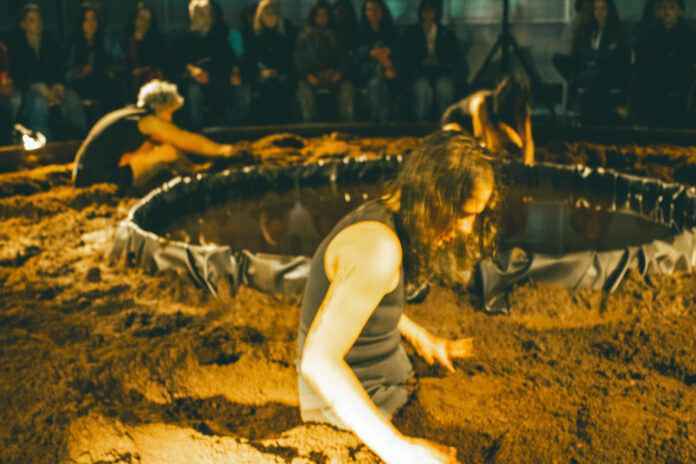From 28 to 30 March, the international art festival La Nomad House returned to Thessaloniki for a new edition. In the atypical setting of L’ Abattoir (Sfagia area), the weekend was punctuated by unique artistic performances around the theme of Women and Migration.
This year’s star attraction was Les Filles de la Mer, created by ARTISTIQUE THÉÂTRE, a French contemporary theatre and dance company.
It was in this spirit that we had the privilege of talking to two of the performance artists, Shaula Cambazzu and Kadek Puspasari. This is not the first time that Artistique Théâtre has taken part in this European cultural format. ‘It’s a big project that took a lot of energy to put together,’ explains choreographer Shaula Cambazzu.
For this new edition, the United Societies of Balkans (USB), supported in part by the Greek Ministry of Culture and the Institut Français, has decided to extend the initiative until 2025. Shaula tells us that preparing for this event represents a real logistical challenge, spanning several months: ‘We’ve been working on this project for a year, in all its aspects: logistics, coordination, sets, we’re taking care of everything ourselves’. This lengthy preparation work reflects the scale and complexity of the event, which involves not only meticulous organisation, but also close collaboration between different actors to bring this unique experience to life. The collaborative aspect of the production echoes the very soul of the play: a project that is both collective and deeply personal.
Shaula and Kadek each have a singular relationship with the art of movement, which brings them even closer to the figures they embody on stage. Shaula’s world, shaped by her career as a dancer, choreographer and author, blends with Kadek’s, steeped in her Indonesian heritage and her exploration of movement. ‘The piece is about women in general, but also about me’, Kadek tells us. Their work on stage goes far beyond mere interpretation; it is an extension of their identities, a means of expressing personal realities while touching on universal themes.
As they explain, their roles on stage have a resonance that is both intimate and universal. ‘We weave together the personal, the universal, the historical and the contextual. For them, artistic creation is a way of confronting and questioning human realities, of linking individual experiences to collective issues. The process of researching and creating the piece revolved around three key words: ‘WOMAN, ISLAND, MIGRATION’. They are interested in MATRIMORY and have investigated heritages, cultures and traditions in order to tell stories that resonate universally. ‘It’s important to us to make the voices and experiences of women heard, because they are too often erased or forgotten’ (Shaula Cambazzu).
It was from these fundamental themes that they began to build the work. The play brings out an inheritance that we all have within us, but which we have to go and find. ‘We drew on our own stories, we each delved into our own characters, and then we put it all together, like a big pot,’ explains the two artists. This metaphor of the ‘pot’ perfectly illustrates the collective process and the fusion of ideas, cultures and experiences that feed the play.
What makes the play unique is its innovative structure, combining a long phase of research and writing with a significant amount of improvisation throughout the creative process. ‘Stage writing’ is at its heart. This concept, which goes beyond writing a text or script before staging, extends to all the work done on stage, in direct interaction with the performers, the space and the other elements of the production. The writing for the stage is built up over the course of the rehearsals, in constant collaboration between the different members of the artistic team, with a particular emphasis on spontaneity and adaptation to the present moment. Each rehearsal has been a field of experimentation, a space where the work is constructed in real time. This dynamic process enriched the piece, nourished by the reactions of the artists and their relationship to the stage.
It is this creative dynamic that transforms the artistic performance into an immersive spectacle for both artists and audience. The constant interaction between the elements – movement, water, words and dance – creates a palpable flow of energy, making the experience all the more intense. As Shaula puts it: ‘Once you enter the space of the piece, you stay there until the end, carried by the elements with which you move. This fusion with the scenic space and its elements makes the experience a profound one, just like a journey where every moment is an exploration.
As for the audience, they find themselves immersed in the experience, placed ‘very close to us, all around the stage’, as Shaula puts it. This proximity to the performers intensifies the authenticity of the performance, making the spectator not only a witness but also an active participant in the energy flowing across the stage.
It’s not just a show to watch, but an experience to live fully, where every movement, every breath and every word counts. This immersive piece is much more than just a cultural event. It is a call to feel, to share and to understand the human realities that unite us, beyond borders and differences.
Thanks again to Shaula Cambazzu and Kadek Puspasari
FRANSIOLY Charlyne and GROSSELIN Lilie
LES FILLES DE LA MER TOURNÉE EN GRECE ! DU 28 AU 30 MARS · THESSALONIQUE DU 4 AU 5 AVRIL · LARISSA DU 11 AU 13 AVRIL · ATHENES
https://www.usbngo.fr/en

